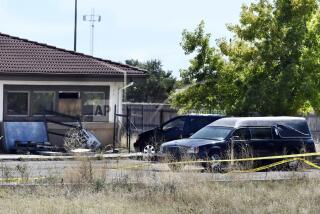Tentative $14-Million Settlement in Suits Against Crematory Unveiled
A tentative settlement was unveiled Thursday that would pay a total of $14 million to up to 12,000 Southern California residents who claimed a Costa Mesa crematory illegally burned and in some cases lost the remains of loved ones.
Under the agreement, Harbor Lawn Memorial Park, its employees and insurers offered to pay the original 363 plaintiffs $3.5 million of the total--$9,642 each--over the next 45 days. The remainder would begin to be paid out if a judge approves the plan in June.
The partial, temporary, and conditional settlement of the massive, 4-year-old lawsuit would apply to Harbor Lawn customers between 1978 and 1985. The agreement was accepted by lawyers representing the majority of the claimants, but still must gain court approval. Plaintiffs could be forced to return settlement funds if a judge fails to approve the agreement in June.
Lawyers for some plaintiffs immediately denounced the pact, pledging to fight it as unfair and illegal at hearings set for June. And attorneys for other major defendants in the case also said they would fight the deal, even though it requires no money to be paid by them.
A lawyer for one defendant, the Neptune Society of Orange County, which used Harbor Lawn for many of the cremations it arranged, said he would contest the settlement.
Tustin attorney Betty J. McMullen, who alone represents 350 plaintiffs in the case, hailed the deal Thursday as a first step toward overall settlement. Eighty percent of her clients are from Orange County, several dozen from Los Angeles and others from “all over the world,” she said Thursday.
“These people suffered from intense emotional, and at times physical, distress when they learned what happened,” said McMullen, who filed the first of what grew to a blizzard of cases against Harbor Lawn, individual mortuaries and the Neptune Society of Orange County.
“And they still don’t know what happened to the remains of their loved ones, and where they are now. Harbor Lawn can’t tell them. The Neptune Society can’t tell them either. They’re never going to know for sure,” McMullen said.
The lawsuits, consolidated by order of the state Supreme Court, allege that corpses were multiply cremated at Harbor Lawn facilities, in violation of state law. In addition to desecration of corpses, many plaintiffs also claim that ashes were commingled and in some cases lost forever. Attorneys for Harbor Lawn have denied any wrongdoing.
The settlement took 10 months to hammer out, under the direction of Orange County Superior Court Judge Jerrold S. Oliver. Before it takes effect, however, it must be approved by Superior Court Judge John L. Flynn.
The climax came Thursday in a Santa Ana courtroom packed with more than 50 lawyers, many of whom had not heard the specifics of Harbor Lawn’s extraordinary offer. Harbor Lawn’s attorneys agreed to pay out $3.5 million for the benefit of plaintiffs before Flynn has even heard opposition to the pact.
If approved, the complicated deal would create three groups of beneficiaries:
- 380 persons who sued Harbor Lawn and other defendants before April 21, 1986, for mishandling remains. Each would receive an equal share of the $3.5 million to be paid into a court-controlled fund by April 27, 1987. Whether that amount would be reduced by attorney fees would be determined by clients and their lawyers.
This group also would share in the $10.5 million to be added by Harbor Lawn and its insurers later.
- The estimated 70 persons who filed lawsuits since April 21, 1986. This group would receive nothing out of the initial $3.5 million, but would share in the additional $10.5 million that Harbor Lawn has agreed to add if the settlement is approved.
- The estimated 11,500 customers of Harbor Lawn between 1978 and 1985 who have not filed claims. Many individual funeral homes which lacked cremation facilities sent cases to Harbor Lawn. If the deal is approved after hearings before Flynn beginning in June, these unknown plaintiffs will be given a deadline, probably four months, within which to file their claims or forfeit them. Next of kin would be notified, but only if the settlement is approved.
According to sources close to the talks, negotiators believed for months that Harbor Lawn’s total insurance coverage was $11,150,000. But the final agreement unveiled Thursday obligates Harbor Lawn to pay $14 million, regardless of what it may receive from other defendants.
Also complicating discussions was the fact that the lion’s share of damages claimed is for the emotional distress suffered by persons who learned of mishandling and commingling of remains of loved ones.
Difficult Question
The difficult question remains how to calculate a value of the distress for purposes of compensation. Because no Harbor Lawn case has gone to trial, and no other similar case has been heard by a jury in the last five years, there was no yardstick to measure damages--at least until last month, lawyers said.
On Feb. 27, an Orange County Superior Court jury fixed damages at $300,000 for an 82-year old widow who claimed another crematory, Pacific View Memorial Park in Newport Beach, had bungled her husband’s cremation and burial.
Federico Sayre, who acted as co-counsel with McMullen in the case, said the evidence against Harbor Lawn is much stronger than that against Pacific View. Jurors were not convinced that Pacific View had conducted cremations of more than one corpse at the same time, a critical element in the case. Sayre said discovery has revealed evidence that Harbor Lawn stuffed six or seven corpses in a single container, and workers desecrated human remains before cremation by stacking them in sometimes-unrefrigerated storage areas.
The proposed settlement with Harbor is too low, by a factor of as much as 10, and represents “an enormous bargain for the defendants,” Sayre said.
The $300,000 verdict should be considered the standard for emotional distress claims, according to Sayre.
‘Fair’ Settlement
“There are varying opinions,” said Marjorie W. Day, who represents several original plaintiffs. Day supported the $14-million deal as a “fair” settlement.
“It’s more than they wanted to pay, and less than we wanted to accept,” Day said.
But the biggest threat to ultimate resolution of the case is a legal one--whether individual plaintiffs should have the option of pursuing their claims outside of any settlement.
Unless the defendants can be sure they know the amount they will have to pay, any partial agreement is difficult to reach.
More to Read
Sign up for Essential California
The most important California stories and recommendations in your inbox every morning.
You may occasionally receive promotional content from the Los Angeles Times.










